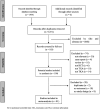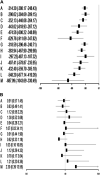Effects of Tranexamic Acid on Hemorrhage Control and Deep Venous Thrombosis Rate After Total Knee Arthroplasty: A Systematic Review and Network Meta-Analysis of Randomized Controlled Trials
- PMID: 34366837
- PMCID: PMC8335562
- DOI: 10.3389/fphar.2021.639694
Effects of Tranexamic Acid on Hemorrhage Control and Deep Venous Thrombosis Rate After Total Knee Arthroplasty: A Systematic Review and Network Meta-Analysis of Randomized Controlled Trials
Abstract
Background: Total knee arthroplasty (TKA) surgery has a lot of complications, especially hemorrhage, which can be controlled via tranexamic acid (TXA). The guidelines endorse the integration of TXA interventions in the management of TKA-induced complications. However, uncertainty surrounds the effects of different TXA therapies. This frequentist model network meta-analysis (NMA) aims to compare hemorrhage control and deep venous thrombosis (DVT) rate of different TXA therapies in TKA. Methods: Articles were searched with the PubMed, Embase, Cochrane Library, and Web of Science from 1966 to October 2020. Randomized controlled trials (RCTs) comparing different TXA therapies, or with placebo in patients with TKA were included. Two investigators independently conducted article retrievals and data collection. The outcome was total blood loss and DVT rate. Effect size measures were mean differences (MDs), or odds ratios (ORs) with 95% confidence intervals (CIs). We conducted a random-effects NMA using a frequentist approach to estimate relative effects for all comparisons and rank treatments according to the mean rank and surface under the cumulative ranking curve values. All analyses were performed in Stata software or R software. The study protocol was registered with PROSPERO, number CRD42020202404. Results: We identified 1 754 citations and included 81 studies with data for 9 987 patients with TKA. Overall, all TXA therapies were superior to placebo for total blood loss in TKA. Of all TXA therapies, M therapy (IV/IV infusion + oral TXA > 3g) was most effective for total blood loss (MD=-688.48, -1084.04--328.93), followed by F therapy (IV TXA ≥ 15 mg/kg or 1 g three times). TXA therapies in this study are not associated with the increase of DVT risk. Conclusions: TXA therapies in this study are effective and safe for the treatment of TKA-induced complications. M therapy (IV/IV infusion + oral TXA > 3 g) may be the most effective TXA therapy for hemorrhage control. TXA therapies in this study do not increase DVT risk. Considering hemorrhage control and DVT rate simultaneously, F therapy (IV TXA ≥ 15 mg/kg or 1 g three times) may be suggested to apply for TKA, and this study may provide a crucial clue to future TXA use.
Keywords: deep vein thrombosis; network meta-analysis; total blood loss; total knee arthroplasty; tranexamic acid.
Copyright © 2021 Ling, Zhao, Xu, Ge and Huang.
Conflict of interest statement
The authors declare that the research was conducted in the absence of any commercial or financial relationships that could be construed as a potential conflict of interest.
Figures




Similar articles
-
Comparing efficacy and safety of 2 methods of tranexamic acid administration in reducing blood loss following total knee arthroplasty: A meta-analysis.Medicine (Baltimore). 2016 Dec;95(50):e5583. doi: 10.1097/MD.0000000000005583. Medicine (Baltimore). 2016. PMID: 27977593 Free PMC article.
-
Is combined use of intravenous and intraarticular tranexamic acid superior to intravenous or intraarticular tranexamic acid alone in total knee arthroplasty? A meta-analysis of randomized controlled trials.J Orthop Surg Res. 2017 Apr 18;12(1):61. doi: 10.1186/s13018-017-0559-2. J Orthop Surg Res. 2017. PMID: 28420413 Free PMC article.
-
The efficacy and safety of combined administration of intravenous and topical tranexamic acid in primary total knee arthroplasty: a meta-analysis of randomized controlled trials.BMC Musculoskelet Disord. 2018 Sep 7;19(1):321. doi: 10.1186/s12891-018-2181-9. BMC Musculoskelet Disord. 2018. PMID: 30193586 Free PMC article. Review.
-
Most Effective Regimen of Tranexamic Acid for Reducing Bleeding and Transfusions in Primary Total Knee Arthroplasty: A Meta-Analysis of Randomized Controlled Trials.J Knee Surg. 2018 Aug;31(7):654-663. doi: 10.1055/s-0037-1606376. Epub 2017 Sep 11. J Knee Surg. 2018. PMID: 28895645
-
The combined effect of administration of intravenous and topical tranexamic acid on blood loss and transfusion rate in total knee arthroplasty: Combined tranexamic acid for TKA.Bone Joint Res. 2016 Aug;5(8):353-61. doi: 10.1302/2046-3758.58.BJR-2016-0001.R2. Bone Joint Res. 2016. PMID: 27587787 Free PMC article.
Cited by
-
Efficacy and safety of tranexamic acid for patients with intertrochanteric fractures treated with intramedullary fixation: A systematic review and meta-analysis of current evidence in randomized controlled trials.Front Pharmacol. 2022 Sep 19;13:945971. doi: 10.3389/fphar.2022.945971. eCollection 2022. Front Pharmacol. 2022. PMID: 36199695 Free PMC article.
-
Development and Validation of a Machine Learning Algorithm to Predict the Risk of Blood Transfusion after Total Hip Replacement in Patients with Femoral Neck Fractures: A Multicenter Retrospective Cohort Study.Orthop Surg. 2024 Aug;16(8):2066-2080. doi: 10.1111/os.14160. Epub 2024 Jul 1. Orthop Surg. 2024. PMID: 38951965 Free PMC article.
References
-
- Adravanti P., Di Salvo E., Calafiore G., Vasta S., Ampollini A., Rosa M. A. (2018). A Prospective, Randomized, Comparative Study of Intravenous Alone and Combined Intravenous and Intraarticular Administration of Tranexamic Acid in Primary Total Knee Replacement. Arthroplasty today 4, 85–88. 10.1016/j.artd.2017.08.004 - DOI - PMC - PubMed
-
- Cao G., Xie J., Huang Z., Huang Q., Chen G., Lei Y., et al. (2018). Efficacy and Safety of Multiple Boluses of Oral versus Intravenous Tranexamic Acid at Reducing Blood Loss after Primary Total Knee Arthroplasty without a Tourniquet: A Prospective Randomized Clinical Trial. Thromb. Res. 171, 68–73. 10.1016/j.thromres.2018.09.054 - DOI - PubMed
-
- Castro-Menéndez M., Pena-Paz S., Rocha-García F., Rodríguez-Casas N., Huici-Izco R., Montero-Viéites A. (2016). Efficacy of 2 Grammes of Intravenous Transexamic Acid in the Reduction of post-surgical Bleeding after Total Hip and Knee Replacement. Revista Española de Cirugía Ortopédica y Traumatología (English Edition) 60, 315–324. 10.1016/j.recote.2016.07.003 - DOI - PubMed
LinkOut - more resources
Full Text Sources
Research Materials
Miscellaneous

